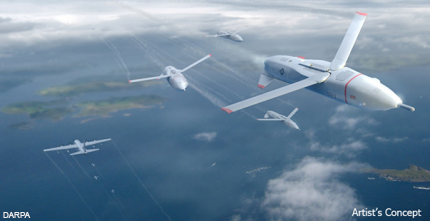DARPA's Gremlins could cut the costs of attack drones
The program would employ cheap UAS that would be launched from a plane, carry out their missions and then drone home.

The military has two types of long-range weapons systems: missiles that can be fired from great distances and are never seen again, and complex aircraft that remain in use for generations. What they have in common is expense, whether they’re one-and-done munitions or aircraft that are costly to build and maintain.
The Pentagon’s lead research arm wants another alternative, looking to develop relatively cheap drones that can be launched from large aircraft or fighters, attack a target or conduct ISR, and then be retrieved in-flight.
The Defense Advanced Research Projects Agency has announced a program it’s calling Gremlins, looking to prove the feasibility of affordable unmanned systems that can be safely launched and recovered in the air, spreading the payload and airframe costs over as many as 20 uses instead of just one. In addition to reusability, DARPA hopes that the program could save money by making use of existing unmanned aircraft rather than designing new models.
Gremlins—named for the imaginary, mischievous creatures that boosted morale among British pilots in World War II—builds on an idea DARPA put forth in November, with a Request for Information on the idea of using large aircraft, such as C-130 transport or the B-52 bomber as “aircraft carriers” for small drones.
Under the Gremlins plan, groups of drones would be launched from large aircraft such as the C-130 or B-52, or from fighters or other smaller aircraft while those manned aircraft are outside the range of an adversary’s defenses. After the gremlins carry out their mission, a C-130 would round them up and take them back to base, where they could be set up for their next mission within 24 hours, DARPA said.
“We wouldn't be discarding the entire airframe, engine, avionics and payload with every mission, as is done with missiles,” program manager Dan Patt said in DARPA’s announcement, “but we also wouldn't have to carry the maintainability and operational cost burdens of today's reusable systems, which are meant to stay in service for decades.”
Cutting the costs of air operations is something the military has been exploring, particularly as the physical skies and the electromagnetic spectrum become more contested. The Air Force in June issued a call for low-cost, expendable attack drones that could be launched from other aircraft and carry out their missions while manned and other expensive craft stay out of harm’s way. (The Air Force noted that, even with drones like its $13 million long-range MQ-9 Reaper, it has focused on long-term durability, driving up costs.)
. The program is focusing on technical areas including:
- Launch and recovery techniques, equipment and aircraft integration concepts.
- Low-cost, limited-life airframe designs.
- High-fidelity analysis, precision digital flight control, relative navigation and station keeping.
DARPA has scheduled a Proposers Day for Sept. 24, at its office in Arlington, Va. More information is available in a Special Notice here.
NEXT STORY: Creative simulations help test new weather radar




